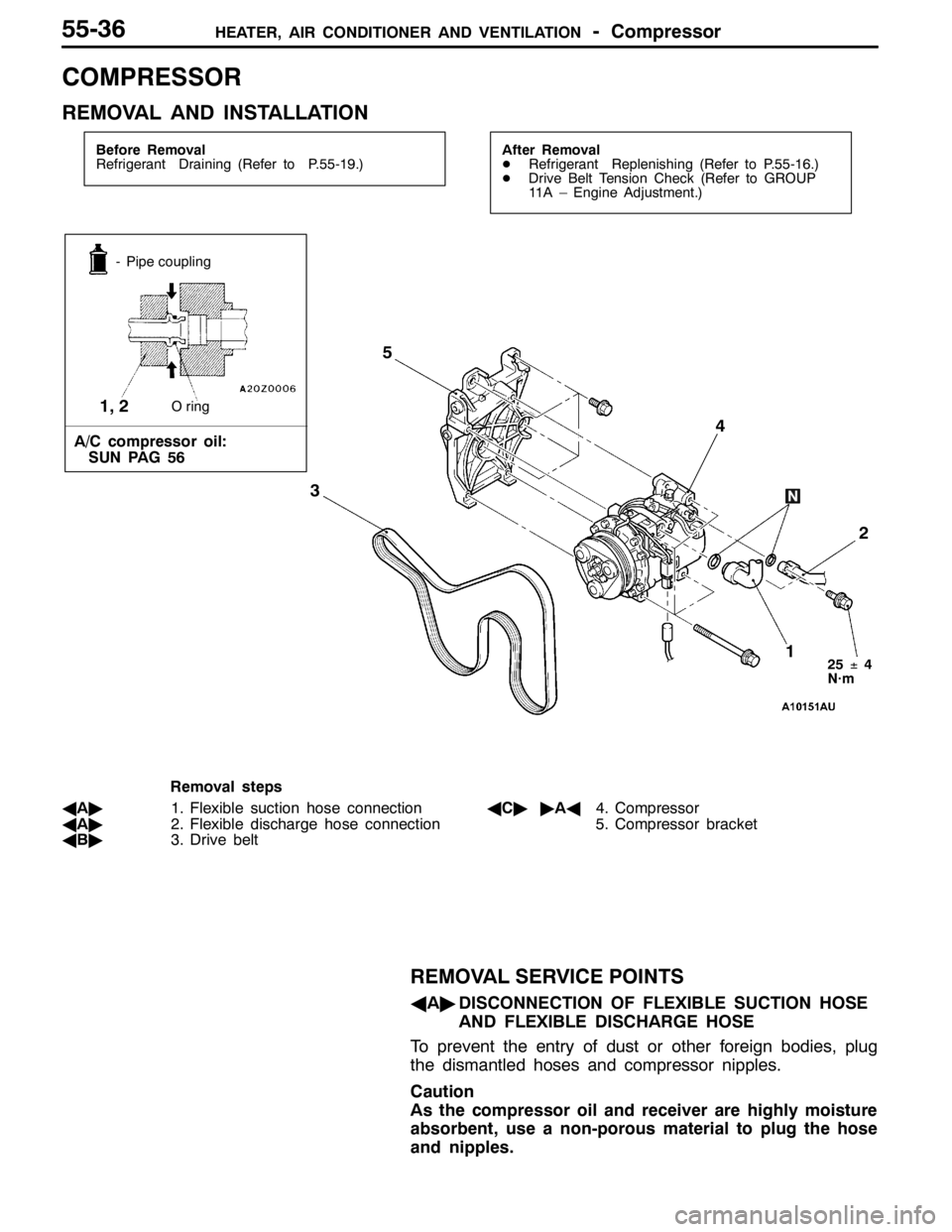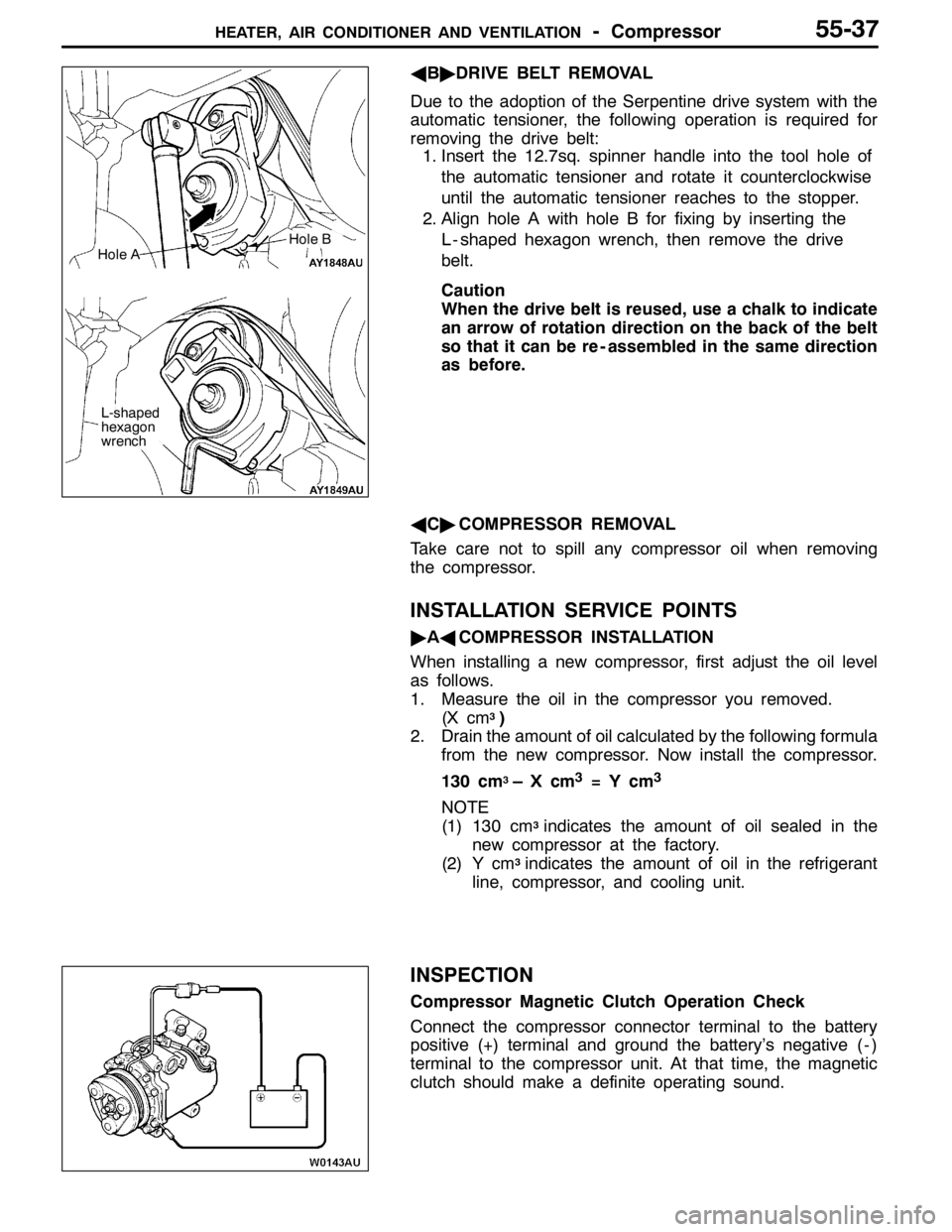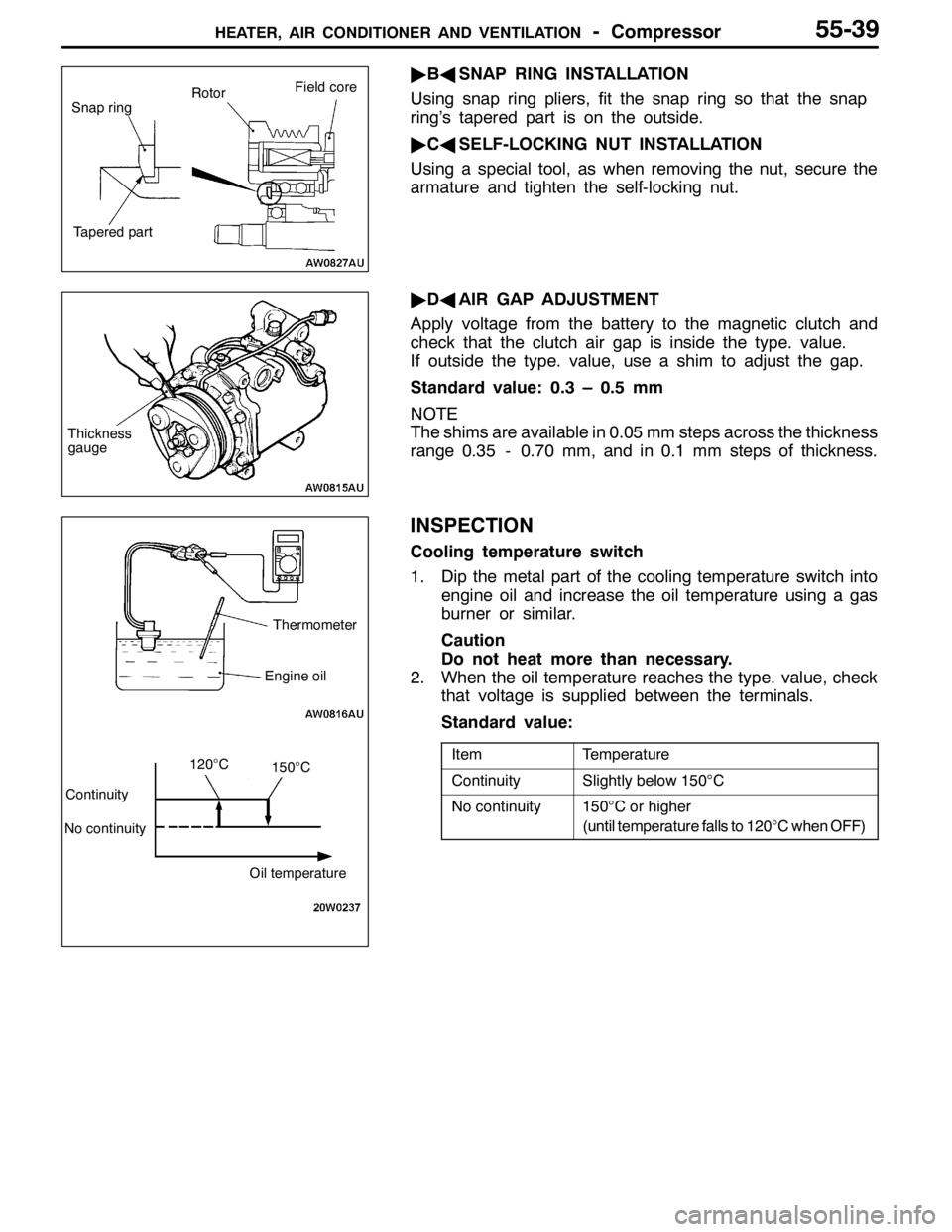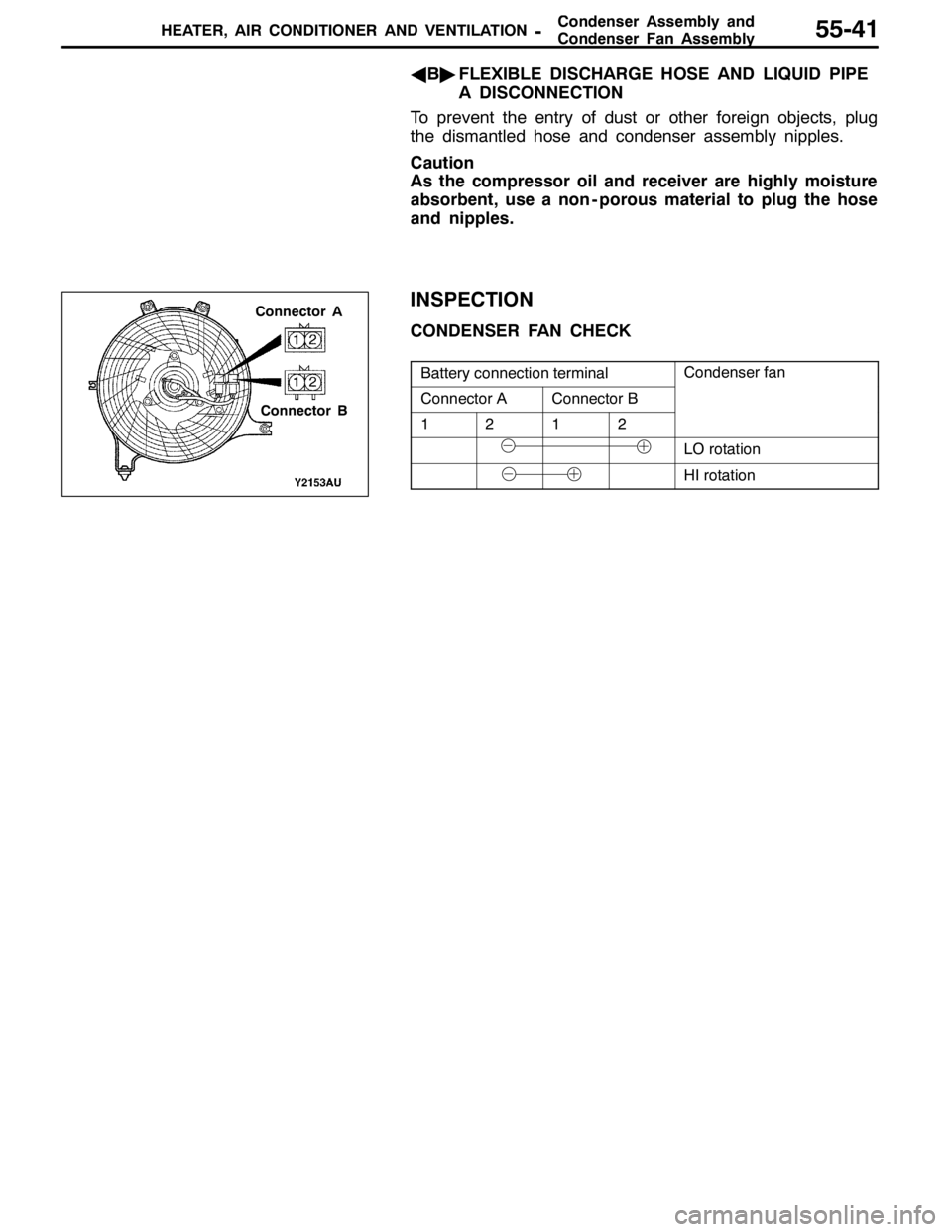2007 MITSUBISHI LANCER EVOLUTION check oil
[x] Cancel search: check oilPage 1421 of 1449

HEATER, AIR CONDITIONER AND VENTILATION–On-vehicle Service HEATER, AIR CONDITIONER AND VENTILATION–On-vehicle Service55-19
8. Start the engine.
9. Operate the air conditioner and set at the lowest
temperature (MAX. COOL).
10. Fix the engine speed at 1,500 r/min.
11. Tighten the handle of the adaptor valve (valve open),
and replenish refrigerant while checking the quantity
through the sight glass.
Caution
If the service can is inverted, liquid refrigerant may
be draw into the compressor damaging it by liquid
compression. Keep the service can upright to ensure
that refrigerant is changed in gas state.
12. After replenishing is completed, turn the handle of the
adaptor valve all the way back (valve close), and remove
the quick joint.
NOTE
When there is remainder of refrigerant in the service can,
keep it for next use with the charge value and the valve
of the adaptor valve being closed.
DISCHARGING SYSTEM
Use the refrigerant recovery unit to discharge refrigerant gas
from the system.
NOTE : Refer to the Refrigerant Recovery and Recycling
Unit Instruction Manual for operation of the unit.
REFILLING OF OIL IN THE A/C SYSTEM
Too little oil will provide inadequate compressor lubrication
and cause a compressor failure. Too much oil will increase
discharge air temperature.
When a compressor is installed at the factory, it contains
130 cm
3of refrigerant oil. While the A/C system is in operation,
the oil is carried through the entire system by the refrigerant.
Some of this oil will be trapped and retained in various parts
of the system.
When the following system components are changed, it is
necessary to add oil to the system to replace the oil being
removed with the component.
Compressor oil: SUN PAG 56
Quantity
Condenser: 180 cm
3
Charging valve
Service can
(Refrigerant container)
Low-pressure
service valve
Page 1423 of 1449

HEATER, AIR CONDITIONER AND VENTILATION–On-vehicle Service55-21
REFRIGERANT LEAK REPAIR
LOST CHARGE
If the system has lost all charge due to a leak:
1. Evacuate the system. (See procedure.)
2. Charge the system with approximately one
pound of refrigerant.
3. Check for leaks.
4. Discharge the system.
5. Repair leaks.
6. Replace receiver drier.
Caution
Replacement filter-drier units must be
sealed while in storage. The drier used in
these units will saturate water quickly upon
exposure to the atmosphere. When
installing a drier, have all tools and supplies
ready for quick reassembly to avoid keeping
the system open any longer than necessary.
7. Evacuate and charge system.
LOW CHARGE
If the system has not lost all of its refrigerant charge;
locate and repair all leaks. If it is necessary to
increase the system pressure to find the leak
(because of an especially low charge) add
refrigerant. If it is possible to repair the leak without
discharging the refrigerant system, use the
procedure for correcting low refrigerant level.HANDLING TUBING AND FITTINGS
Kinks in the refrigerant tubing or sharp bends in
the refrigerant hose lines will greatly reduce the
capacity of the entire system. High pressures are
produced in the system when it is operating.
Extreme care must be exercised to make sure that
all connections are pressure tight. Dirt and moisture
can enter the system when it is opened for repair
or replacement of lines or components. The
following precautions must be observed. The
system must be completely discharged before
opening any fitting of connection in the refrigeration
system. Open fittings with caution even after the
system has been discharged. If any pressure is
noticed as a fitting is loosened, allow trapped
pressure to bleed off very slowly.
Never attempt to rebend formed lines to fit. Use
the correct line for the installation you are servicing.
A good rule for the flexible hose lines is keep the
radius of all bends at least 10 times the diameter
of the hose.
Sharper bends will reduce the flow of refrigerant.
The flexible hose lines should be routed so that
they are at least 80 mm from the exhaust manifold.
It is good practice to inspect all flexible hose lines
at least once a year to make sure they are in good
condition and properly routed.
Unified plumbing connections with O-rings, these
O-rings are not reusable.
COMPRESSOR NOISE
You must first know the conditions when the noise
occurs. These conditions are: weather, vehicle
speed, in gear or neutral, engine temperature or
any other special conditions.
Noises that develop during A/C operation can often
be misleading. For example: what sounds like a
failed front bearing or connecting rod, may be
caused by loose bolts, nuts, mounting brackets,
or a loose clutch assembly. Verify accessory drive
belt tension (power steering or alternator).
Improper accessory drive belt tension can cause
a misleading noise when the compressor is
engaged and little or no noise when the compressor
is disengaged.
Drive belts are speed-sensitive. That is, at different
engine speeds, and depending upon belt tension,
belts can develop unusual noises that are often
mistaken for mechanical problems within the
compressor.ADJUSTMENT
1. Select a quiet area for testing. Duplicate
conditions as much as possible. Switch
compressor on and off several times to clearly
identify compressor noise. To duplicate high
ambient conditions (high head pressure),
restrict air flow through condenser. Install
manifold gauge set to make sure discharge
pressure doesn’t exceed 2,070 kPa.
2. Tighten all compressor mounting bolts, clutch
mounting bolt, and compressor drive belt.
Check to assure clutch coil is tight (no rotation
or wobble).
3. Check refrigerant hoses for rubbing or
interference that can cause unusual noises.
4. Check refrigerant charge. (See “Charging
System”.)
5. Recheck compressor noise as in Step 1.
6. If noise still exists, loosen compressor mounting
bolts and retorque. Repeat Step 1.
7. If noise continues, replace compressor and
repeat Step 1.
Page 1438 of 1449

HEATER, AIR CONDITIONER AND VENTILATION-Compressor55-36
COMPRESSOR
REMOVAL AND INSTALLATION
Before Removal
Refrigerant Draining (Refer to P.55-19.)After Removal
DRefrigerant Replenishing (Refer to P.55-16.)
DDrive Belt Tension Check (Refer to GROUP
11A – Engine Adjustment.)
25±4
N·m
2 4
1
- Pipe coupling
O ring
A/C compressor oil:
SUN PAG 56
1, 2
5
3
Removal steps
AA"1. Flexible suction hose connection
AA"2. Flexible discharge hose connection
AB"3. Drive beltAC""AA4. Compressor
5. Compressor bracket
REMOVAL SERVICE POINTS
AA"DISCONNECTION OF FLEXIBLE SUCTION HOSE
AND FLEXIBLE DISCHARGE HOSE
To prevent the entry of dust or other foreign bodies, plug
the dismantled hoses and compressor nipples.
Caution
As the compressor oil and receiver are highly moisture
absorbent, use a non-porous material to plug the hose
and nipples.
Page 1439 of 1449

HEATER, AIR CONDITIONER AND VENTILATION-Compressor55-37
AB"DRIVE BELT REMOVAL
Due to the adoption of the Serpentine drive system with the
automatic tensioner, the following operation is required for
removing the drive belt:
1. Insert the 12.7sq. spinner handle into the tool hole of
the automatic tensioner and rotate it counterclockwise
until the automatic tensioner reaches to the stopper.
2. Align hole A with hole B for fixing by inserting the
L - shaped hexagon wrench, then remove the drive
belt.
Caution
When the drive belt is reused, use a chalk to indicate
an arrow of rotation direction on the back of the belt
so that it can be re - assembled in the same direction
as before.
AC"COMPRESSOR REMOVAL
Take care not to spill any compressor oil when removing
the compressor.
INSTALLATION SERVICE POINTS
"AACOMPRESSOR INSTALLATION
When installing a new compressor, first adjust the oil level
as follows.
1. Measure the oil in the compressor you removed.
(X cm
3)
2. Drain the amount of oil calculated by the following formula
from the new compressor. Now install the compressor.
130 cm
3–Xcm3=Ycm3
NOTE
(1) 130 cm3indicates the amount of oil sealed in the
new compressor at the factory.
(2) Y cm
3indicates the amount of oil in the refrigerant
line, compressor, and cooling unit.
INSPECTION
Compressor Magnetic Clutch Operation Check
Connect the compressor connector terminal to the battery
positive (+) terminal and ground the battery’s negative ( - )
terminal to the compressor unit. At that time, the magnetic
clutch should make a definite operating sound.
Hole A
L-shaped
hexagon
wrench
Hole B
Page 1441 of 1449

HEATER, AIR CONDITIONER AND VENTILATION-Compressor55-39
"BASNAP RING INSTALLATION
Using snap ring pliers, fit the snap ring so that the snap
ring’s tapered part is on the outside.
"CASELF-LOCKING NUT INSTALLATION
Using a special tool, as when removing the nut, secure the
armature and tighten the self-locking nut.
"DAAIR GAP ADJUSTMENT
Apply voltage from the battery to the magnetic clutch and
check that the clutch air gap is inside the type. value.
If outside the type. value, use a shim to adjust the gap.
Standard value: 0.3 – 0.5 mm
NOTE
The shims are available in 0.05 mm steps across the thickness
range 0.35 - 0.70 mm, and in 0.1 mm steps of thickness.
INSPECTION
Cooling temperature switch
1. Dip the metal part of the cooling temperature switch into
engine oil and increase the oil temperature using a gas
burner or similar.
Caution
Do not heat more than necessary.
2. When the oil temperature reaches the type. value, check
that voltage is supplied between the terminals.
Standard value:
ItemTemperature
ContinuitySlightly below 150°C
No continuity150°C or higher
(until temperature falls to 120°C when OFF)
Snap ringRotorField core
Tapered part
Thickness
gauge
Thermometer
Engine oil
Continuity
No continuity
Oil temperature
120°C150°C
Page 1443 of 1449

CondenserAssemblyand
Condenser Fan Assembly HEATER, AIR CONDITIONER AND VENTILATION-55-41
AB"FLEXIBLE DISCHARGE HOSE AND LIQUID PIPE
A DISCONNECTION
To prevent the entry of dust or other foreign objects, plug
the dismantled hose and condenser assembly nipples.
Caution
As the compressor oil and receiver are highly moisture
absorbent, use a non - porous material to plug the hose
and nipples.
INSPECTION
CONDENSER FAN CHECK
Battery connection terminalCondenser fan
Connector AConnector B
1212
LO rotation
HI rotation
Connector A
Connector B